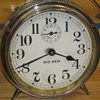Posted 14 years ago
 bigben
bigben
(72 items)
Schatz "London Coach" 400 day clock made in September 1955.
Why 400 Day Clocks Run So Long
Typical clocks run either one day or eight days on one winding. To make 400 day clocks run longer, a torsion pendulum is used. A torsion pendulum hangs from a thin wire and rotates in one direction and then the other, instead of swinging back and forth as a standard pendulum does.
Standard 400 Day Clock (about 12 inches tall)
A Standard or full sized 400 day clock has a torsion pendulum which makes a rotation in 7.5 seconds, or 8 rotations each minute (four rotations in each direction). The clock makes one “tick” near the end of each rotation. Preceding each tick, a gear with pointed teeth called the escape wheel has been giving an impulse to the pallet assembly. During impulse, a vertical pin in the pallet assembly pushes a fork to the left or right. The fork applies this energy to the suspension spring (the thin wire holding the pendulum), and the suspension spring transfers some of this energy to the pendulum.
The clock movement supplies one unit of energy to the pendulum for each oscillation. A torsion pendulum oscillates about 8 to 20 times more slowly than a swinging pendulum. This represents a major savings in energy, enough for an 8-day clock run 64 to 160 days. Further energy savings is obtained by using smaller pivots (load bearing areas on the ends of gear arbors or shafts) and by using small gears. By having more gears than an 8 day clock, the mainspring is made to unwind slowly enough for the clock to run about 400 days.
Miniature 400 Day Clock (about 8 - 9 inches tall)
Miniature 400 day clocks are built on the same principles as the standard models, but use smaller gears and pivots, making them even more energy efficient. The most popular models, those by Schatz and Kundo, have pendulums making 10 rotations per minute. Other makes have pendulum rotation rates of from 6 to 10 rotations per minute.



















Love your pictures and all the info. I have 2 of these clocks at home. One is just like your picture and the other is made in 1956 with a little different dome. They both were repaired by a professional clock repairman several years ago. The cases are not made of glass but some type of plastic? Can you tell me the best way to clean the brass? I would love to get them in the condition of your picture, but there is some pitting on the brass. I hate to part with them, but I may need to sell for financial reasons. Hope to hear from you. Your collection is really great.
Peggy, I would not try to polish it unless you are prepared to take the all the pieces of the case apart. I use a polishing machine for the top of the cover, and use Brasso metal polish for some of the smaller pieces. If you don't take it apart for polishing, it will corrode after a while, as you can't get all the metal polish out. Most of these have plastic panels (the earliest ones did have glass).
Bigben, i have a christopher columbus clock like yours from the 1868? fair . Could you please tell me what it's worth Thank you
I have a Schatz Feb 1958 London Coach 400 day clock, it runs well, what is the typical value for one of these?
I have one of these Schatz clocks and am in need of the Suspension Spring (Wire).
Can you point me in the right direction to purchase a couple of these?
Thanks, Sassie
after the death of my father, i found a Schatz London 400 Coach clock. What is the value/price if in good shape and running?
Absolute beauty. Neil